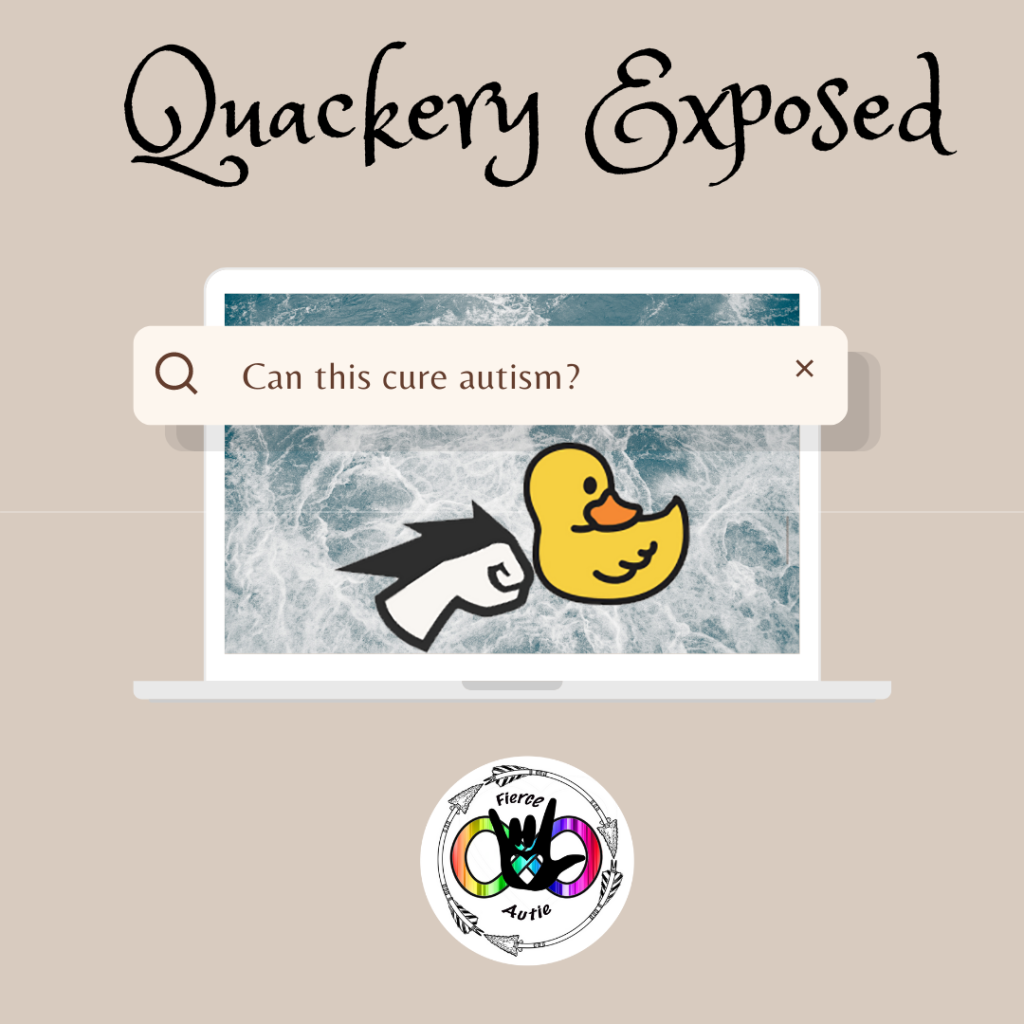
What is Suramin?
Suramin is used in the treatment of African sleeping sickness (African trypanosomiasis) and river blindness (onchocerciasis), infections caused by parasites. This medication causes the parasites to lose energy which causes them to die.
Before Using Suramin
- Allergies
- Tell your doctor if you have ever had any unusual or allergic reactions to this medication or any other medication. Also tell your doctor if you have any other types of allergies, such as to foods, dyes, preservatives, or animals. For OTC products, read the label or package very carefully.
- Pediatric
- Suramin can cause serious side effects in any patient. It is very important that you discuss with the child’s doctor the good that this medication may do as well as the risks.
- Geriatric
- Elderly people are especially sensitive to the effects of suramin. This may increase the chance of side effects during treatment.
Suramin causes some serious side effects:
Uncommon Side Effects:
- Cloudy urine
- crawling or tingling sensation of the skin
- diarrhea
- faintness, especially after missing meals
- headache
- increased skin color
- irritability
- itching
- joint pain
- loss of appetite
- nausea
- numbness or weakness in arms, hands, legs, or feet
- skin rash
- stinging sensation on the skin
- swelling on skin
- tenderness of the palms and the soles
- tire easily
- vomiting
Less Common
- Changes in or loss of vision
- extreme tiredness or weakness
- increased sensitivity of eyes to light
- painful tender glands in the neck, armpits, or groin
- swelling around eyes
- ulcers or sores in the mouth
- watery eyes
Rare Side Effects:
- Cold and clammy skin
- convulsions
- decreased blood pressure
- difficulty in breathing
- fever and sore throat
- fever with or without chills
- increased heartbeat
- loss of consciousness
- pale skin
- pinpoint red spots on the skin
- red, thickened, or scaly skin
- swelling and/or tenderness in the upper abdominal or stomach area
- swollen and/or painful glands
- unusual bleeding or bruising
- unusual tiredness or weakness
- yellow eyes or skin
More Common
- Abdominal pain
- fever
- the general feeling of discomfort
- metallic taste
Being Recruited For a Study of Suramin
On March 11, 2020, I was messaged about participating and promoting a study to “improve autism.”I got defensive and told her she was an ableist. Here is the original message:
 |
|
Hi, I have a favor to ask. I’m trying to help a friend that is involved with getting participants for a study trying to predict autism, Dr Robert Naviaux, the Dr that is researching Suramin for the treatment of ADS needs 400 children, 200 with and 200 without autism before they can even start. If they don’t have all participants enrolled by June 1, 2020, they will have to start the whole application process over.
This study may help PREVENT children from EVER developing ASD
Genetic vulnerability + certain environmental exposures = ASD
|
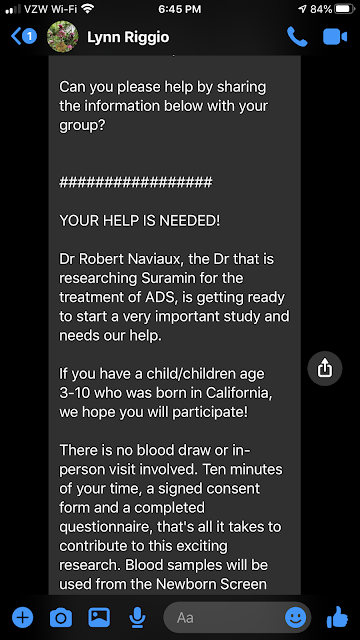 |
|
Can you please help by sharing the information below with your group?
#################
YOUR HELP IS NEEDED!
Dr Robert Naviaux, the Dr that is researching Suramin for the treatment of ADS, is getting ready to start a very important study and needs our help.
If you have a child/children age 3-10 who was born in California, we hope you will participate!
There is no blood draw or in-person visit involved. Ten minutes of your time, a signed consent form and a completed questionnaire, that’s all it takes to contribute to this exciting research. Blood samples will be used from the Newborn Screen
|
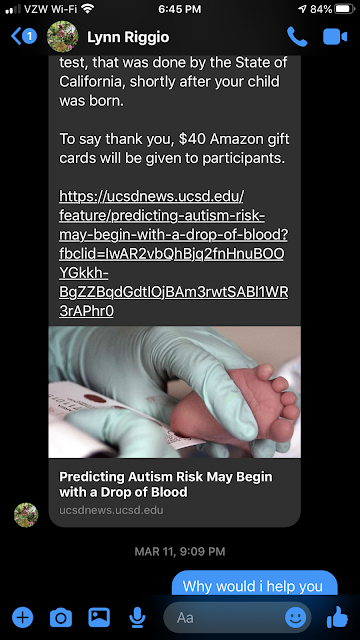 |
|
test, that was done by the State of California, shortly after your child was born.
To say thank you, $40 Amazon gift cards will be given to participants.
Predicting Autism Risk May Begin with a Drop of Blood
Within days of birth, a few drops of blood are collected from every newborn in California—and across the United States—which are then stored on filter paper and screened for dozens of genetic and congenital disorders, such as phenylketonuria (PKU), an inherited metabolic disorder that can result…
ucsdnews.ucsd.edu
MAR 11, 2020, 9:09 PM
Amanda
Why would i help you commit eugenics?
|
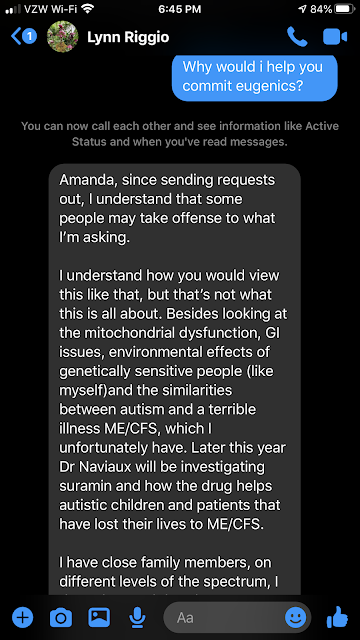 |
|
You can now call each other and see information like Active Status and when you’ve read messages.
Lynn Riggio
Lynn
Amanda, since sending requests out, I understand that some people may take offense to what I’m asking.
I understand how you would view this like that, but that’s not what this is all about. Besides looking at the mitochondrial dysfunction, GI issues, environmental effects of genetically sensitive people (like myself)and the similarities between autism and a terrible illness ME/CFS, which I unfortunately have. Later this year Dr Naviaux will be investigating suramin and how the drug helps autistic children and patients that have lost their lives to ME/CFS.
I have close family members, on different levels of the spectrum,
|
 |
|
I do understand that there are co-occurring medical conditions. I have watched my sister care for her nonverbal son for 30 years. If Dr Naviaux could discover why the mitochondrial problems exist, or how to help the nonverbal autistic community communicate with those that love them, if there was something that would improve his life, I would push for it.
I apologize if my request has upset you and I thank you for taking the time to share your thoughts with me.
Amanda
I’m autistic and t4 should be a thing of the past. Isn’t my existence valid?
Do you even know what t4 is?
Your eugenics leads to this
(photo of intestinal lining from bleach enemas)
|
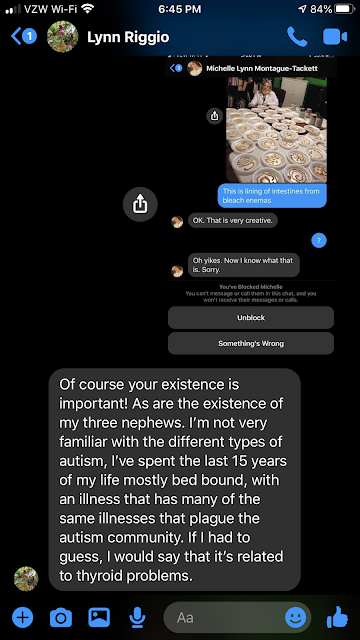 |
|
Lynn Riggio
Lynn
Of course your existence is important! As are the existence of my three nephews. I’m not very familiar with the different types of autism, I’ve spent the last 15 years of my life mostly bed bound, with an illness that has many of the same illnesses that plague the autism community. If I had to guess, I would say that it’s related to thyroid problems.
|
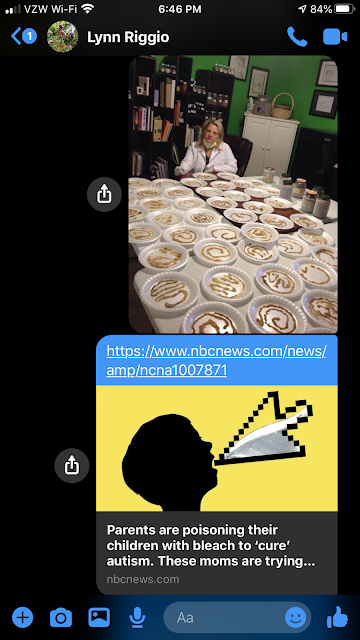 |
|
Amanda
Parents are poisoning their children with bleach to ‘cure’ autism. These moms are trying to stop it.
Private Facebook groups urge parents to poison autistic kids with chlorine dioxide to “cure” them. These moms are going undercover to fight back.
nbcnews.com
|
This study is supported and pushed by TACA. TACA’s founder, Lisa Ackerman states,” In 2020, one of the most promising autism treatment research projects, Suramin, is heading in the next phases.” This is the same organization that was pushing the chelation study which was canceled due to safety concerns.
‘Dr. Naviaux reported in his TACA talk on October 20, 2019, “The UC San Diego Naviaux lab team had a great meeting with the FDA this summer. They are very supportive of the Suramin trials. The company making the new Suramin now thinks they will be able to launch the SAT2 trial in Spring 2021. Preparing for the SAT2 is a many-step process that is keeping dozens of dedicated people busy. We are making steady progress. Once we are within 6 months of an actual start date, I will be able to give a more precise estimate of when we will actually begin enrolling patients.”’
The doctor is Robert Naviaux. He is a professor of medicine, pediatrics, and pathology at the University of California at San Diego. He is also the co-director of the Mitochondrial and Metabolic Disease Center. His study was to prove the effectiveness of suramin for autism. Suramin is a 100-year-old medication used for River Blindness and His theory was that the drug suramin would trigger a cell danger hypothesis.
In this study, Naviaux claims that 1-5% of the population is autistic. According to the CDC, the percentage of the American population is 15%. This is inaccurate. This is because there are many autistic people in the United States who are undiagnosed.
The study also states “not every child is exposed to the same environmental factors.” This could possibly refer to vaccines. The study does not specifically state what “symptoms” they are looking to “improve.” The aims of the study are not specific enough.
His inclusion criteria were the subjects must be male, meet the DSM V criteria, be ages 4-17, live in San Diego, and have a confirmed autism diagnosis. The sample size was 10 boys. That’s a far reach from 200. Exclusion criteria were children who weighed less than the 5th percentile for age, took prescription medication, and had laboratory evidence of liver, kidney, heart, or adrenal abnormalities. Parents were asked not to change therapy during the clinical trial. All participants were matched in IQ, “functioning level,” and age.
This study is flawed. This study only includes 10 children. Half the participants were given the drug and the other half were given a placebo. Girls were excluded. The study does not state what the “core symptoms” they are trying to “improve.” They only state the improve the “core symptoms” but they do not specify which “symptoms” they are talking about.
The parent in the accompanying video said when a parent is desperate to change their child they will try random medications to see if they work. There is a problem with this. There is a laundry list of side effects.
The study professionals did record the different adverse events:

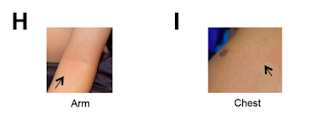
With these adverse reactions, the study professionals stated there were no safety concerns. They clearly recorded the adverse reactions to the drug.
After reading all this, NO ONE should be giving this drug with the variety of adverse effects of this medication.
“Special note from the researchers: Suramin is not approved for the treatment of autism. Like many intravenous drugs, when administered improperly by untrained personnel, at the wrong dose and schedule, without careful measurement of drug levels and monitoring for toxicity, suramin can cause harm. Careful clinical trials will be needed over several years at several sites to learn how to use low-dose suramin safely in autism and to identify drug-drug interactions and rare side effects that cannot currently be predicted. We strongly caution against the unauthorized use of suramin.”
Phase II Study of Suramin
A clinical trial biopharmaceutical (biomedical) firm PaxMedica, conducted a phase II study on Suramin.
On November 7, 2023, PaxMedidca announced the findings of this phase II trial.
This study was led by Chief Medical Officer Dr. David Hough. He had a team of co-authors who specialized in autism.
This study’s purpose was to evaluate the efficacy and safety of suramin IV infusions with 10 mg. kg suramin.
They say it delivers promising results.
The study
Right away, I saw that the study report was not organized per the American Psychological Association guidelines. I will attempt to do that in my analysis.
This phase II trial was published in the Annals of General Psychiatry
A 14-week, randomized, double-blind, placebo-controlled study that had 52 boy participants. They had no girls. The boys were aged 4-17 years old.
They start off by saying:
There is a critical need for the effective treatment of the core symptioms of autism spectrum disorder (ASD).
THe background section of the study report
They hope to “treat” autism with medication in order to “restore normal mitochondrial function and reduction of neuro-inflammation”
They then site a nonclinical study involving mice in a fragile X study. Fragile x is not autism, even though there are autistics with fragile x.
Study Objective
The primary objective of the study was to investigate the safety, tolerability, and efficacy of suramin in autistic children.
Study Sample
The study sample was 52 autistic boys 4-17 years of age. There were originally 48 but increased to 52 to replace the 5 that dropped out due to the pandemic.
The study investigators confirmed an autism diagnosis based on the Autism Diagnostic Observation Schedule – Second Edition (ADOS-2) comparison score.
Inclusion criteria:
- boys
- age 4-17
- diagnosis of autism by the DSM 5
- ADOS-2 comparison scores in the moderate and high levels as evaluated on the ADOS-2 and stable treatment intervention for more than 2 months. This does not specify what the treatment is. Most likely ABA.
Exclusion criteria:
- psychiatric hospitalization within the past 2 months
- acute medical problem
- Rett syndrome
- microcephaly
- tuberous sclerosis
- neurofibromatosis
- epilepsy
- “children with known syndromic forms of ASD caused by DNA mutation or chromosomal copy number variation”
- liver, kidney, or adrenal disease
- weight under the 5th percentile for age
- plasma creatine above normal for age and weight, according to the laboratory reference ranges
- liver enzyme alanine aminotransferase (ALT) or aspartate aminotransferase (AST) 1.5 times the upper end of normal
- known intolerance to suramin or other anti-purinergic drugs
- not being male
They left out a large part of the autistic community, but ok.
Study Design
The study was a proof of concept, prospective, randomized, double-blind, placebo-controlled, multicenter, dose-ranging study of 2 doses of suramin (10mg/kg and 20mg/kg) versus placebo in 52 autistic boys aged 4-17 years old.
Method:
This study was conducted between May 2019 and December 2020. There was a pause of about 6 months due to the pandemic. This caused 5 participants to drop out.
There were 3 intravenous (IV) infusions to the following treatment groups:
- 20mg/kg of suramin group
- 10 mg/kg of suramin group
- placebo
This study took place at 6 sites in South Africa, where suramin is a registered medicine and was approved by the South African Health Products Regulatory Authority and the National Health Research Ethics Council on February 19, 2019.
They could not legally do this in the United States so they went to Africa to do this. This is a common theme.
Each site was an outpatient treatment center and participants were recruited by local advertising.
Each family was given a small stipend to cover out-of-pocket expenses for each study visit. The amount was approved by the local ethics committee.
The efficacy of the suramin was determined by parent checklists:
- Aberrant Behavior Checklist (ABC). They defend the use of this checklist in the study report.
- Clinical Global Impressions of Improvement
- Autism Treatment Evaluation Checklist (ATEC put out by the founder of MAPS and Cure Autism Now)
They also used the Expressive One-Word Picture Vocabulary Test (EOWPVT)
Results:
The 10mg/kg group showed a greater but statistically nonsignificant improvement compared with the placebo and 20mg/kg group.
“Suramin infusion did not demonstrate a monotonic dose response for efficacy”
Adverse Reactions

PaxMedica announced that this study showed promise but there were a lot of adverse reactions with these children. Four children even withdrew from the study because of the adverse reactions.
We are highly encouraged by the findings of our study, which provides signifcant isights into the potential of suramin as a safe and effective treatment for the cure sumptoms of ASD
Dr. David Hough, Chief Medical Officer at PaxMedica
Due to the Study, PaxMedica Stock is Up 95%
According to Business Insider, PAxMedica’s stock is rising higher as investors celebrate the company’s publication of the phase II trial. This is the same study that had numerous side effects. Oh, I forgot. These are autistic kids so all they are about is making them appear neurotypical.
What does this mean for their stock?
Investors are excited about the potential to make autistics appear neurotypical. Because of this, 23 million shares were traded. The average trading volume is close to 141,000 shares.
I hope they are happy with themselves. They are making money off the expense of autistic children. I bet they did not even look into the dangerous side effects of this medication. They would care more if these were neurotypical children.
Autistic children are people and this world needs to realize this.
Sources:
Cell danger response hypothesis – MEpediawww.me-pedia.org › wiki › Cell_danger_response_hyp…
https://health.ucsd.edu/news/topics/suramin-autism/pages/default.aspx
https://onlinelibrary.wiley.com/doi/pdf/10.1002/acn3.424
https://tacanowblog.com/2019/11/04/suramin-research-status/#more-4911
https://pubmed.ncbi.nlm.nih.gov/31646477/
https://www.mayoclinic.org/drugs-supplements/suramin-injection-route/precautions/drg-20066167



